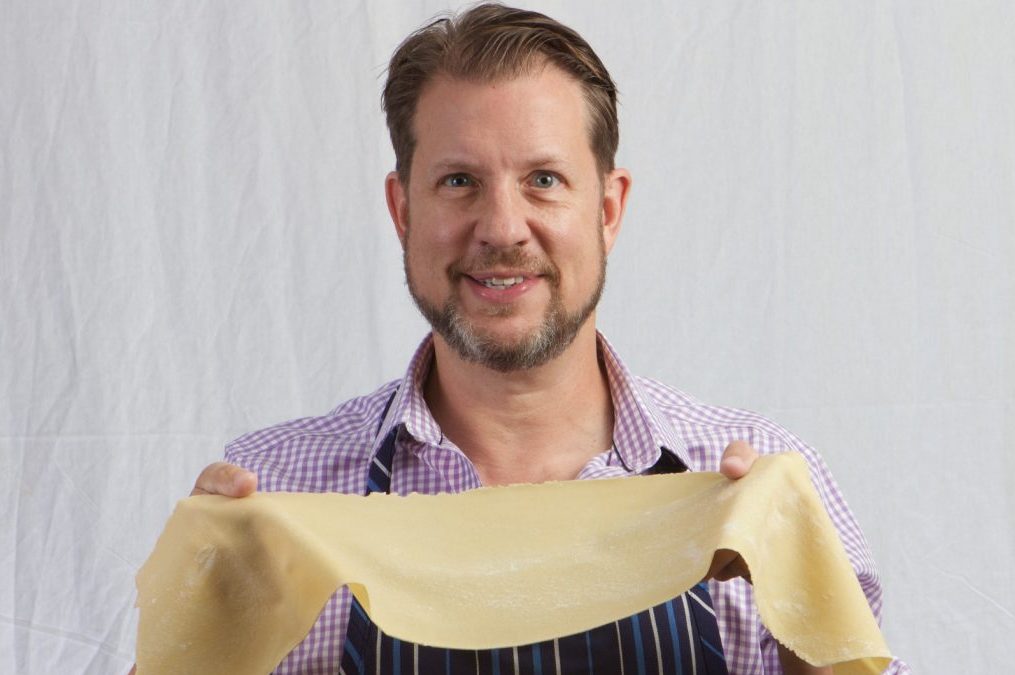Fresh pasta from scratch is a favorite in the Knight household. Fresh pasta cooks in three minutes and is fun to make. And you can customize it: in another blog post I described how I made lime pasta to complement a shrimp filling.
My usual go-to pasta recipe contains two ingredients: flour and eggs. I follow the 3:2 ratio for pasta dough. Three parts flour to two parts eggs, by weight. The tricky thing is that eggs can vary in size and flour’s density will vary based on humidity. For this reason, I consider a digital scale an essential piece of equipment in my kitchen. They are very affordable, compact, and can make it easy to scale recipes.
I estimate that one egg’s worth of pasta is enough for two people. I will break the eggs into a container on my scale to weigh them. I divide that weight by two and multiply by three to find the amount of flour to use. To be honest, I don’t do the math. I use the Ratio app based on Michael Ruhlman’s book Ratio: The Simple Codes Behind the Craft of Everyday Cooking.
I use my mixer’s dough hook attachment to knead the dough. If you don’t have a mixer with a dough hook, you can knead by hand until the dough is smooth. Wrap the dough in plastic wrap and let it sit in the refrigerator for 30 minutes.
For years I used the classic Atlas pasta machine my mother had given to me for Christmas. It’s what got me started making my own noodles. More recently, I upgraded to the pasta roller attachment for my mixer. They both do the exact same thing: allow you to roll the dough progressively thinner.
I start with an approximately 70 gram piece of dough while leaving the rest of it wrapped in the refrigerator. I dip in in flour and roll it through the roller on setting “1.” After rolling it through I fold it in thirds and pass it through again. If it feels sticky, I will dust it with flour. After passing it through “1” three times after folding, I will change the dial to “2” and repeat the process. First passing it through unfolded and then folding it in thirds three times and passing it through the roller. Then I change to dial to “3” and follow the same procedure. By now the dough should be dry and flexible and rolling easily. I will pass it through successive roller setting without any more folding. I find on my roller, if I go thinner than “5” the dough gets pretty flimsy and difficult to handle. Now the giant noodle is ready to be shaped. I usually use the cutter roller from my Atlas pasta machine to cut fettuccine. I frequently make ravioli as well. I now use a ravioli mold which is an efficient way to make the stuffed pasta, but when I first started, I would use a water glass to cut the pasta into circles, place the filling in one-half of the circle, then fold it over and crimp. You could also cut squares and do a similar thing. Place the shaped pasta onto a cloth-lined sheet pan and move on to the next handful of dough.
Once you’ve turned all of your dough into beautifully-shaped pasta artforms, it’s time to cook it by placing it in boiling, salted water. Fresh pasta cooks quite a bit faster than store-bought. I typically recommend checking it after approximately 3 minutes (as opposed to the standard 9-11 minutes for dried pasta) to avoid overcooking. If I plan to eat right after making the pasta, I will start the water boiling as I start to roll out the dough. You can also make the pasta ahead of time. I will even make extra large batches of ravioli and freeze some for a quick weeknight meal. The noodles are so yummy, I don’t sauce them heavily. A little butter or olive oil and a grating of cheese or a light sauce like pesto are perfect. You’ve got fresh, homemade pasta from scratch.
Check out a recent video on YouTube of Dr. Colin Knight teaching a friend how to make ravioli.

